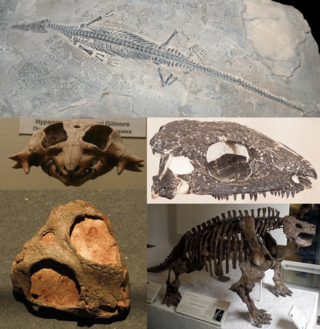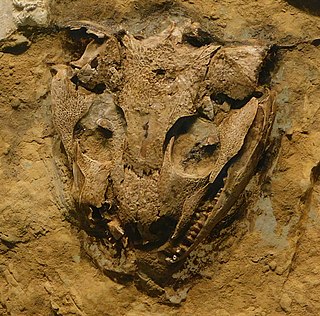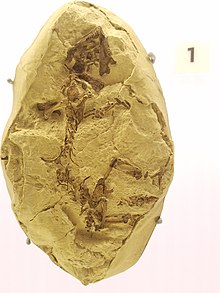
Synapsida is one of the two major clades of vertebrate animals in the group Amniota, the other being the Sauropsida. The synapsids were the dominant land animals in the late Paleozoic and early Mesozoic, but the only group that survived into the Cenozoic are mammals. Unlike other amniotes, synapsids have a single temporal fenestra, an opening low in the skull roof behind each eye orbit, leaving a bony arch beneath each; this accounts for their name. The distinctive temporal fenestra developed about 318 million years ago during the Late Carboniferous period, when synapsids and sauropsids diverged, but was subsequently merged with the orbit in early mammals.

Diapsids are a clade of sauropsids, distinguished from more primitive eureptiles by the presence of two holes, known as temporal fenestrae, in each side of their skulls. The group first appeared about three hundred million years ago during the late Carboniferous period. All diapsids other than the most primitive ones in the clade Araeoscelidia are sometimes placed into the clade Neodiapsida. The diapsids are extremely diverse, and include birds and all modern reptile groups, including turtles, which were historically thought to lie outside the group. Although some diapsids have lost either one hole (lizards), or both holes, or have a heavily restructured skull, they are still classified as diapsids based on their ancestry. At least 17,084 species of diapsid animals are extant: 9,159 birds, and 7,925 snakes, lizards, tuatara, turtles, and crocodiles.

"Labyrinthodontia" is an informal grouping of extinct predatory amphibians which were major components of ecosystems in the late Paleozoic and early Mesozoic eras. Traditionally considered a subclass of the class Amphibia, modern classification systems recognize that labyrinthodonts are not a formal natural group (clade) exclusive of other tetrapods. Instead, they consistute an evolutionary grade, ancestral to living tetrapods such as lissamphibians and amniotes. "Labyrinthodont"-grade vertebrates evolved from lobe-finned fishes in the Devonian, though a formal boundary between fish and amphibian is difficult to define at this point in time.

Lepospondyli is a diverse taxon of early tetrapods. With the exception of one late-surviving lepospondyl from the Late Permian of Morocco, lepospondyls lived from the Visean stage of the Early Carboniferous to the Early Permian and were geographically restricted to what is now Europe and North America. Five major groups of lepospondyls are known: Adelospondyli; Aïstopoda; Lysorophia; Microsauria; and Nectridea. Lepospondyls have a diverse range of body forms and include species with newt-like, eel- or snake-like, and lizard-like forms. Various species were aquatic, semiaquatic, or terrestrial. None were large, and they are assumed to have lived in specialized ecological niches not taken by the more numerous temnospondyl amphibians that coexisted with them in the Paleozoic. Lepospondyli was named in 1888 by Karl Alfred von Zittel, who coined the name to include some tetrapods from the Paleozoic that shared some specific characteristics in the notochord and teeth. Lepospondyls have sometimes been considered to be either related or ancestral to modern amphibians or to Amniota. It has been suggested that the grouping is polyphyletic, with aïstopods being primitive stem-tetrapods, while recumbirostran microsaurs are primitive reptiles.

Aistopoda is an order of highly specialised snake-like stegocephalians known from the Carboniferous and Early Permian of Europe and North America, ranging from tiny forms only 5 centimetres (2 in), to nearly 1 metre (3.3 ft) in length. They first appear in the fossil record in the Mississippian period and continue through to the Early Permian.
Lethiscus is the earliest known representative of the Aistopoda, a group of very specialised snake-like tetrapodomorphs known from the early Carboniferous (Mississippian).

Reptiliomorpha is a clade containing the amniotes and those tetrapods that share a more recent common ancestor with amniotes than with living amphibians (lissamphibians). It was defined by Michel Laurin (2001) and Vallin and Laurin (2004) as the largest clade that includes Homo sapiens, but not Ascaphus truei. Laurin and Reisz (2020) defined Pan-Amniota as the largest total clade containing Homo sapiens, but not Pipa pipa, Caecilia tentaculata, and Siren lacertina.

Protorothyrididae is an extinct family of small, lizard-like reptiles belonging to Eureptilia. Their skulls did not have fenestrae, like the more derived diapsids. Protorothyridids lived from the Late Carboniferous to Early Permian periods, in what is now North America. Many genera of primitive reptiles were thought to be protorothyridids. Brouffia, Coelostegus, Paleothyris and Hylonomus, for example, were found to be more basal eureptiles in Muller and Reisz (2006), making the family as historically defined paraphyletic, though three genera, Protorothyris, Anthracodromeus, and Cephalerpeton, were recovered as a monophyletic group. Anthracodromeus, Paleothyris, and Protorothyris were recovered as a monophyletic group in Ford and Benson (2020), who recovered them as more derived than captorhinids and Hylonomus, but less so than araeoscelidians. Anthracodromeus is the earliest known reptile to display adaptations to climbing. The majority of phylogenetic studies recover protorothyridids as basal members of Eureptilia; however, Simões et al. (2022) recover them as stem-amniotes instead.

Captorhinidae is an extinct family of tetrapods, typically considered primitive reptiles, known from the late Carboniferous to the Late Permian. They had a cosmopolitan distribution across Pangea.

Petrolacosaurus is an extinct genus of diapsid reptile from the late Carboniferous period. It was a small, 40-centimetre (16 in) long reptile, and one of the earliest known reptile with two temporal fenestrae. This means that it was at the base of Diapsida, the largest and most successful radiation of reptiles that would eventually include all modern reptile groups, as well as dinosaurs and other famous extinct reptiles such as plesiosaurs, ichthyosaurs, and pterosaurs. However, Petrolacosaurus itself was part of Araeoscelida, a short-lived early branch of the diapsid family tree which went extinct in the mid-Permian.

Westlothiana is a genus of reptile-like tetrapod that lived about 338 million years ago during the latest part of the Viséan age of the Carboniferous. The genus is known from a single species, Westlothiana lizziae. It is the oldest known uncontroversial tetrapod, closely related to but not an amniote.

Parareptilia ("near-reptiles") is an extinct subclass or clade of basal sauropsids/reptiles, typically considered the sister taxon to Eureptilia. Parareptiles first arose near the end of the Carboniferous period and achieved their highest diversity during the Permian period. Several ecological innovations were first accomplished by parareptiles among reptiles. These include the first reptiles to return to marine ecosystems (mesosaurs), the first bipedal reptiles, the first reptiles with advanced hearing systems, and the first large herbivorous reptiles. The only parareptiles to survive into the Triassic period were the procolophonoids, a group of small generalists, omnivores, and herbivores. The largest family of procolophonoids, the procolophonids, rediversified in the Triassic, but subsequently declined and became extinct by the end of the period.

Utatsusaurus hataii is the earliest-known ichthyopterygian which lived in the Early Triassic period. It was nearly 2.5–3 metres (8.2–9.8 ft) long with a slender body. The first specimen was found in Utatsu-cho, Miyagi Prefecture, Japan. It is the only described species in the genus Utatsusaurus and the only member of the family Utatsusauridae. The name Utatsusaurus was given after the city. The fossils have been found from the Early Triassic Osawa Formation of Miyagi Prefecture, Japan and British Columbia, Canada.

Scincosaurus is an extinct genus of nectridean tetrapodomorphs within the family Scincosauridae.

Chanaresuchus is an extinct genus of proterochampsid archosauriform. It was of modest size for a proterochampsian, being on average just over a meter in length. The type species is Chanaresuchus bonapartei was named in 1971. Its fossils were found in from the early Carnian-age Chañares Formation in La Rioja Province, Argentina. Chanaresuchus appears to be one of the most common archosauriforms from the Chañares Formation due to the abundance of specimens referred to the genus. Much of the material has been found by the La Plata-Harvard expedition of 1964-65. Chanaresuchus is the most well-described proterochampsid in the subfamily Rhadinosuchinae.

Tuditanidae is an extinct family of microsaurian tetrapods. Fossils have been found from Nova Scotia, Ohio, and the Czech Republic and are Late Carboniferous in age.

Reptiles arose about 320 million years ago during the Carboniferous period. Reptiles, in the traditional sense of the term, are defined as animals that have scales or scutes, lay land-based hard-shelled eggs, and possess ectothermic metabolisms. So defined, the group is paraphyletic, excluding endothermic animals like birds that are descended from early traditionally-defined reptiles. A definition in accordance with phylogenetic nomenclature, which rejects paraphyletic groups, includes birds while excluding mammals and their synapsid ancestors. So defined, Reptilia is identical to Sauropsida.

Euconcordia is an extinct genus of Late Carboniferous captorhinid known from Greenwood County, Kansas of the United States.
Eusauropleura is an extinct genus of gephyrostegid reptiliomorph from the Pennsylvanian of Linton, Ohio. The type species and only species, Eusauropleura digitata, was first described by American paleontologist Edward Drinker Cope in 1868 as Sauropleura digitata. In 1930, paleontologist Alfred Romer placed the species in the new genus Eusauropleura. Romer considered S. digitata to be a reptile or a more primitive relative of reptiles, making it only distantly related to Sauropleura, which is a lepospondyl amphibian.

Edopoidea is a clade of primitive temnospondyl amphibians including the genus Edops and the family Cochleosauridae. Edopoids are known from the Late Carboniferous and Early Permian of North America and Europe, and the Late Permian of Africa. They are among the most basal temnospondyls, and possess a number of primitive features that were lost in later members of the group.
Arjan, Mann, et al. “Carbonodraco Lundi Gen Et Sp. Nov., the Oldest Parareptile, from Linton, Ohio, and New Insights into the Early Radiation of Reptiles.” Royal Society Open Science, 27 Nov. 2019, royalsocietypublishing.org/doi/10.1098/rsos.191191.























